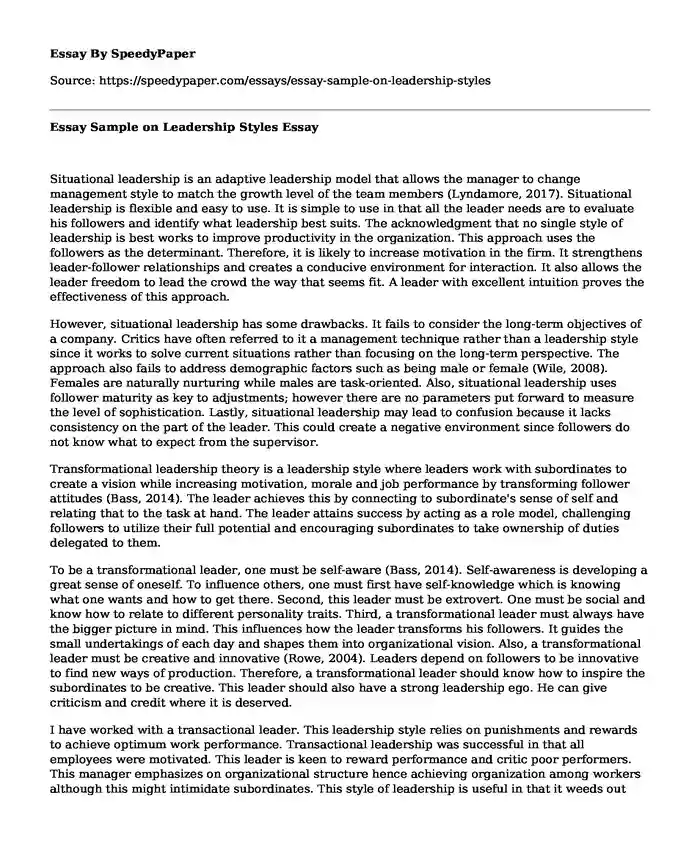
| Type of paper: | Course work |
| Categories: | Leadership style Transformational leadership |
| Pages: | 3 |
| Wordcount: | 625 words |
Situational leadership is an adaptive leadership model that allows the manager to change management style to match the growth level of the team members (Lyndamore, 2017). Situational leadership is flexible and easy to use. It is simple to use in that all the leader needs are to evaluate his followers and identify what leadership best suits. The acknowledgment that no single style of leadership is best works to improve productivity in the organization. This approach uses the followers as the determinant. Therefore, it is likely to increase motivation in the firm. It strengthens leader-follower relationships and creates a conducive environment for interaction. It also allows the leader freedom to lead the crowd the way that seems fit. A leader with excellent intuition proves the effectiveness of this approach.
However, situational leadership has some drawbacks. It fails to consider the long-term objectives of a company. Critics have often referred to it a management technique rather than a leadership style since it works to solve current situations rather than focusing on the long-term perspective. The approach also fails to address demographic factors such as being male or female (Wile, 2008). Females are naturally nurturing while males are task-oriented. Also, situational leadership uses follower maturity as key to adjustments; however there are no parameters put forward to measure the level of sophistication. Lastly, situational leadership may lead to confusion because it lacks consistency on the part of the leader. This could create a negative environment since followers do not know what to expect from the supervisor.
Transformational leadership theory is a leadership style where leaders work with subordinates to create a vision while increasing motivation, morale and job performance by transforming follower attitudes (Bass, 2014). The leader achieves this by connecting to subordinate's sense of self and relating that to the task at hand. The leader attains success by acting as a role model, challenging followers to utilize their full potential and encouraging subordinates to take ownership of duties delegated to them.
To be a transformational leader, one must be self-aware (Bass, 2014). Self-awareness is developing a great sense of oneself. To influence others, one must first have self-knowledge which is knowing what one wants and how to get there. Second, this leader must be extrovert. One must be social and know how to relate to different personality traits. Third, a transformational leader must always have the bigger picture in mind. This influences how the leader transforms his followers. It guides the small undertakings of each day and shapes them into organizational vision. Also, a transformational leader must be creative and innovative (Rowe, 2004). Leaders depend on followers to be innovative to find new ways of production. Therefore, a transformational leader should know how to inspire the subordinates to be creative. This leader should also have a strong leadership ego. He can give criticism and credit where it is deserved.
I have worked with a transactional leader. This leadership style relies on punishments and rewards to achieve optimum work performance. Transactional leadership was successful in that all employees were motivated. This leader is keen to reward performance and critic poor performers. This manager emphasizes on organizational structure hence achieving organization among workers although this might intimidate subordinates. This style of leadership is useful in that it weeds out non-performing employees and encourages the rest to utilize their potential fully. The action-oriented style ensures that work gets done.
References
Bass, B. M., & Riggio, R. E. (2014). Transformational leadership. New York: Routledge.
Lydamore, V. (2017, September 26). Retrieved from https://bizfluent.com/info-7851680ssituational-leadership-pro-cons.html
Rowe, L., Linton Productions, National Center for Outcome Based Education, & Video Journal of Education. (2004). Transformational leadership. Salt Lake City, UT: Video Journal of Education.
Wile, E. (2008). Negatives of a Situational Leadership Style. Retrieved from http://smallbusiness.chron.com/negatives-situational-leadership-style-18606.html
Cite this page
Essay Sample on Leadership Styles. (2022, May 06). Retrieved from https://speedypaper.net/essays/essay-sample-on-leadership-styles
Request Removal
If you are the original author of this essay and no longer wish to have it published on the SpeedyPaper website, please click below to request its removal:
- Free Essay Example on Soil Drainage
- Role of Media in Politics - Free Essay for Students' Use
- Human Development and Life Transition Issues - Free Essay in Psychology
- National Guidelines for Healthcare, Free Essay
- Islam Empire Of Faith - Free Essay with the Movie Review
- Business Valuation: Estimating the Economic Value of a Company
- Website Review. Paper Example
Popular categories




